Sōma
相馬市 | |
|---|---|
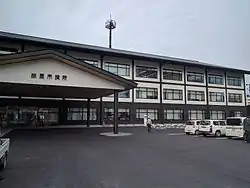 Sōma City Hall | |
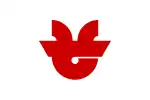 Flag 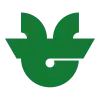 Emblem | |
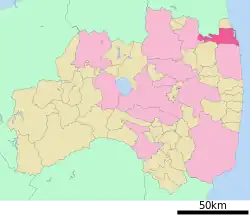 Location of Sōma in Fukushima Prefecture | |
 Sōma | |
| Coordinates: 37°47′48″N 140°55′10.7″E / 37.79667°N 140.919639°E | |
| Country | Japan |
| Region | Tōhoku |
| Prefecture | Fukushima |
| Government | |
| • Mayor | Hidekiyo Tachiya |
| Area | |
| • Total | 197.79 km2 (76.37 sq mi) |
| Population (February 29, 2020) | |
| • Total | 34,631 |
| • Density | 180/km2 (450/sq mi) |
| Time zone | UTC+09:00 (Japan Standard Time) |
| Phone number | 0244-37-2117 |
| Address | 13 Nakamura Ōtesaki, Sōma-shi, Fukushima-ken 976-8601 |
| Climate | Cfa |
| Website | Official website |
| Symbols | |
| Bird | Japanese bush warbler |
| Flower | Spring: sakura Summer: rugosa rose Autumn: balloon flower Winter: sazanka |
| Tree | Japanese black pine |
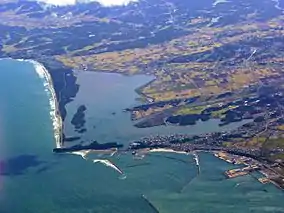
Sōma (相馬市, Sōma-shi) is a city located in Fukushima Prefecture, Japan. As of 29 February 2020, the city had an estimated population of 34,631, and a population density of 180 persons per km2 in 14,358 households.[1] The total area of the city is 197.79 square kilometres (76.37 sq mi).
Geography
Sōma is located in northeastern Fukushima Prefecture, bordered by the Pacific Ocean to the east and the Abukuma Plateau to the west. Sōma is closer to Sendai in Miyagi Prefecture than it is to the prefectural capital of Fukushima.
- Mountains
- Mount Ryōzen (825m)
- Rivers
- Uda River
- Coastal features
Neighboring municipalities
- Fukushima Prefecture
- Miyagi Prefecture
Climate
Sōma has a humid climate (Köppen climate classification Cfa) characterized by mild summers and cold winters with heavy snowfall. The average annual temperature in Sōma is 12.6 °C. The average annual rainfall is 1260 mm with September as the wettest month. The temperatures are highest on average in August, at around 24.8 °C, and lowest in January, at around 1.8 °C.[2]
| Climate data for Sōma (1991−2020 normals, extremes 1976−present) | |||||||||||||
|---|---|---|---|---|---|---|---|---|---|---|---|---|---|
| Month | Jan | Feb | Mar | Apr | May | Jun | Jul | Aug | Sep | Oct | Nov | Dec | Year |
| Record high °C (°F) | 18.4 (65.1) |
22.7 (72.9) |
26.0 (78.8) |
31.0 (87.8) |
32.5 (90.5) |
36.3 (97.3) |
36.8 (98.2) |
37.6 (99.7) |
35.7 (96.3) |
31.1 (88.0) |
26.4 (79.5) |
23.0 (73.4) |
37.6 (99.7) |
| Mean daily maximum °C (°F) | 6.7 (44.1) |
7.3 (45.1) |
10.6 (51.1) |
15.8 (60.4) |
20.4 (68.7) |
23.0 (73.4) |
26.6 (79.9) |
28.2 (82.8) |
25.0 (77.0) |
20.0 (68.0) |
14.8 (58.6) |
9.5 (49.1) |
17.3 (63.2) |
| Daily mean °C (°F) | 2.2 (36.0) |
2.5 (36.5) |
5.4 (41.7) |
10.5 (50.9) |
15.5 (59.9) |
19.0 (66.2) |
22.7 (72.9) |
24.2 (75.6) |
20.8 (69.4) |
15.4 (59.7) |
9.7 (49.5) |
4.7 (40.5) |
12.7 (54.9) |
| Mean daily minimum °C (°F) | −2.5 (27.5) |
−2.3 (27.9) |
0.0 (32.0) |
5.0 (41.0) |
10.9 (51.6) |
15.6 (60.1) |
19.7 (67.5) |
20.8 (69.4) |
17.1 (62.8) |
10.8 (51.4) |
4.4 (39.9) |
−0.1 (31.8) |
8.3 (46.9) |
| Record low °C (°F) | −11.9 (10.6) |
−14.0 (6.8) |
−8.5 (16.7) |
−5.4 (22.3) |
1.6 (34.9) |
7.3 (45.1) |
11.7 (53.1) |
12.5 (54.5) |
7.3 (45.1) |
−0.7 (30.7) |
−3.9 (25.0) |
−9.2 (15.4) |
−14.0 (6.8) |
| Average precipitation mm (inches) | 47.4 (1.87) |
34.6 (1.36) |
77.8 (3.06) |
97.4 (3.83) |
113.0 (4.45) |
146.9 (5.78) |
190.8 (7.51) |
166.8 (6.57) |
225.0 (8.86) |
198.8 (7.83) |
60.3 (2.37) |
34.9 (1.37) |
1,381.2 (54.38) |
| Average precipitation days (≥ 1.0 mm) | 4.2 | 4.9 | 7.9 | 8.5 | 9.2 | 12.5 | 13.7 | 11.7 | 11.9 | 8.7 | 5.8 | 4.8 | 103.8 |
| Mean monthly sunshine hours | 180.3 | 175.5 | 193.2 | 193.7 | 192.2 | 147.5 | 132.8 | 156.8 | 129.1 | 144.2 | 152.9 | 163.9 | 1,961.9 |
| Source: Japan Meteorological Agency[3][4] | |||||||||||||
Demographics
Per Japanese census data,[5] the population of Sōma has remained the same over the past 40 years.
| Year | Pop. | ±% |
|---|---|---|
| 1920 | 27,858 | — |
| 1930 | 31,627 | +13.5% |
| 1940 | 31,887 | +0.8% |
| 1950 | 44,375 | +39.2% |
| 1960 | 41,352 | −6.8% |
| 1970 | 37,189 | −10.1% |
| 1980 | 37,332 | +0.4% |
| 1990 | 39,134 | +4.8% |
| 2000 | 38,842 | −0.7% |
| 2010 | 37,817 | −2.6% |
| 2020 | 34,631 | −8.4% |
History
The area of present-day Sōma was part of ancient Mutsu Province, and has been settled since at least the Jōmon period. During the Edo period, the area developed as the castle town of Sōma Domain, home of the Sōma clan from the Kamakura period until the Boshin War. After the Meiji Restoration, it was organized as part of Iwaki Province. With the establishment of the modern municipalities system on April 1, 1896, the area was organized into a number of towns and villages within the districts of Namekata and Uda. In 1896, Namekata and Uda were merged to create Sōma District. The town of Nakamura was established on April 1, 1889. Nakamura was merged with seven neighbouring villages and raised to city status on March 31, 1954, becoming the city of Sōma.
2011 earthquake and tsunami
The eastern, coastal portion of Sōma was inundated by tsunami flood waters following the magnitude 9.1 2011 Tōhoku earthquake and tsunami off its coastline on March 11, 2011.[6] The tsunami reached up to approximately 4 km inland in Sōma; flooded areas included Sōma Port and the Matsukawa-ura Bay area, up to the elevated Route 6 Sōma Bypass.[7] The tsunami was measured to have been 9.3 meters or higher in Sōma.[8]
Sōma is about 45 kilometres (28 miles) north of Fukushima Daiichi Nuclear Power Plant, the site of the nuclear accident that followed the tsunami, and was thus not subject to mandatory evacuation.[9]
Government
Sōma has a mayor-council form of government with a directly elected mayor and a unicameral city legislature of 20 members.[10] Sōma, together with the town of Shinchi contributes one member to the Fukushima Prefectural Assembly. In terms of national politics, the city is part of Fukushima 1st district of the lower house of the Diet of Japan.
Economy
Sōma has a mixed economy, based on agriculture, commercial fishing and light manufacturing. The area is noted for its strawberry cultivation. The Shinchi Thermal Power Station, a coal-fired thermal power station is located in Sōma.
Education
Sōma has nine public elementary schools and four public junior high schools operated by the city and two public high schools operated by the Fukushima Prefectural Board of Education. The prefecture also operates one special education school.
Hospital
Soma General Hospital, a public hospital with 240 beds, is located in Sōma.
Transportation
Railway
![]() East Japan Railway Company (JR East) - Jōban Line
East Japan Railway Company (JR East) - Jōban Line
Highway
 Jōban Expressway – Sōma Interchange
Jōban Expressway – Sōma Interchange Tōhoku-Chūō Expressway – Sōma Interchange – Sōma Yamakami Interchange – Sōma Tamano Interchange
Tōhoku-Chūō Expressway – Sōma Interchange – Sōma Yamakami Interchange – Sōma Tamano Interchange National Route 6
National Route 6 National Route 115
National Route 115 National Route 116
National Route 116
Seaports
- Port of Soma
Local attractions
- The Sōma horse-chasing Festival held on July 23 to 25 every year is a designated an Important Intangible Folk Cultural Property.[11]
- Sōma Nakamura Castle ruins
- Sōma Nakamura Shrine
- Matsukawaura Prefectural Natural Park
- Mount Ryōzen, National Place of Scenic Beauty and a National Historic Site
Noted people from Sōma
- Tochiazuma Tomoyori, sumo wrestler
- Takahiro Suzuki, professional baseball player
- Tikashi Fukushima, artist.
References
- ↑ Sōma city official home page(in Japanese)
- ↑ Sōma climate data
- ↑ 観測史上1~10位の値(年間を通じての値). JMA. Retrieved March 20, 2022.
- ↑ 気象庁 / 平年値(年・月ごとの値). JMA. Retrieved March 20, 2022.
- ↑ Sōma population statistics
- ↑ Kyodo News, "Survivors in trauma after life-changing nightmare day", The Japan Times, 13 March 2011, p. 2.
- ↑ NHK, TV News Broadcast, 13 March 2011.
- ↑ http://www.jma.go.jp/en/tsunami/observation_2_04_20110313180559.html JMA tsunami observation data.
- ↑ Fukushima evacuation orders and restricted areas
- ↑ Sōma City Council membership list(in Japanese)
- ↑ Agency for Cultural Affairs (in Japanese)
Further reading
Sasaki, Takashi (2013). Fukushima: vivir el desastre (in Spanish). Translated by F. Javier de Esteban Baquedano. Gijón, Spain: Satori Ediciones. ISBN 978-84-941125-3-9.
External links
- Official Website (in Japanese)